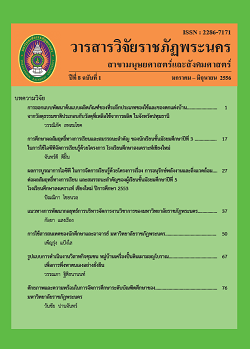รูปแบบการเรียนรู้ตามแนวคิดของคอล์บของนักศึกษาชั้นปีที่ 1 ปีการศึกษา 2554 มหาวิทยาลัยราชภัฏพระนคร
Main Article Content
Abstract
ผลการวิจัยพบว่า
1. นักศึกษาชั้นปีที่ 1 มหาวิทยาลัยราชภัฏพระนคร มีรูปแบบการเรียนรู้ตามแนวคิดของคอล์บแบบ ซึมซับเป็นอันดับหนึ่ง รองลงมาเป็นแบบคิดเอกนัย แบบคิดอเนกนัย และแบบปรับปรุง ตามลำดับ เมื่อจำแนก ตามเพศและคณะ พบว่า อันดับของรูปแบบการเรียนรู้ไม่แตกต่างกัน
2. รูปแบบการเรียนรู้ตามแนวคิดของคอล์บกับเพศของนักศึกษาชั้นปีที่ 1 มหาวิทยาลัยราชภัฏ พระนคร ไม่มีความสัมพันธ์กัน แต่มีความสัมพันธ์กับคณะ อย่างมีนัยสำคัญทางสถิติที่ระดับ .05
Learning Styles of the First-year Students of Phranakhon Rajabhat University Based on Kolb's Model
This research aimed to investigate and determine the relation between Kolb’s learning styles and the personal factors namely genders and faculties of the full-time first-year undergraduates who studied in four-year curriculum and were admitted to the university in 2011. The samples included 1,182 students. The research instrument was Kolb’s model learning program which was based on the test of David Kolb’s learning styles. The data were collected through the Internet and were analyzed by using percentage and Chi-square test.
The results were as follows:
1. The learning style of most first-year undergraduates of Phranakhon Rajabhat University was assimilating, followed by converging, diverging, and accommodating respectively. When the personal factors, namely genders and faculties were taken into consideration, the findings remained the same.
2. The students' learning styles based on Kolb's models bore no relation to their genders but their learning models related to the faculties at the significant level of 0.05
Article Details
Each publish articles were copyright by Phranakorn Rajabhat University
Any contents which appeared in each articles in the journal were authors personal opinion. It did not relate to Phranakorn Rajabhat University and other instructors in the university. Each authors would take responsibility on their articles. If there are any mistake, the authors will take responsibility themselves


